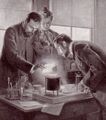Template:Selected anniversaries/December 26: Difference between revisions
Jump to navigation
Jump to search
No edit summary |
No edit summary |
||
| Line 1: | Line 1: | ||
<gallery> | <gallery> | ||
||1780 – Mary Somerville, Scottish mathematician, astronomer, and author (d. 1872) | |||
File:Charles Babbage by Antoine Claudet c1847-51.jpg|link=Charles Babbage (nonfiction)|1791: Polymath [[Charles Babbage (nonfiction)|Charles Babbage]] born. He will pioneer the concept of a digital programmable computer. | File:Charles Babbage by Antoine Claudet c1847-51.jpg|link=Charles Babbage (nonfiction)|1791: Polymath [[Charles Babbage (nonfiction)|Charles Babbage]] born. He will pioneer the concept of a digital programmable computer. | ||
||Martin(us) van Marum ( | |File:Siegel der Universitat Leipzig.png|link=Leipzig University (nonfiction)|1878: "[[Leipzig University (nonfiction)|Leipzig University]] should include me in seal," says [[Friedrich Nietzsche (nonfiction)|Friedrich Nietzsche]]. | ||
||Martin(us) van Marum (b. 26 December 1837, Haarlem) was a Dutch physician, inventor, scientist and teacher, who studied medicine and philosophy in Groningen. Van Marum introduced modern chemistry in the Netherlands after the theories of Lavoisier, and several scientific applications for general use. He became famous for his demonstrations with instruments, most notable the Large electricity machine, to show statical electricity and chemical experiments while curator for the Teylers Museum. | |||
||1862 – The largest mass-hanging in U.S. history took place in Mankato, Minnesota, 38 Native Americans died. | |||
||1896: Georgi Nadjakov born | ||1896: Georgi Nadjakov born | ||
File:Curie_and_radium_by_Castaigne.jpg|link=Radium (nonfiction)|1898: Marie and Pierre Curie announce the isolation of [[Radium (nonfiction)|radium]]. | File:Curie_and_radium_by_Castaigne.jpg|link=Radium (nonfiction)|1898: Marie and Pierre Curie announce the isolation of [[Radium (nonfiction)|radium]]. | ||
||1991 – The Supreme Soviet of the Soviet Union meets and formally dissolves the Soviet Union. | |||
||1997 – Cahit Arf, Turkish mathematician and academic (b. 1910) | |||
File:Martin David Kruskal.jpg|link=Martin David Kruskal (nonfiction)|2006: Physicist and mathematician [[Martin David Kruskal (nonfiction)|Martin David Kruskal]] dies. He made fundamental contributions in many areas of mathematics and science, including the discovery and theory of solitons. | File:Martin David Kruskal.jpg|link=Martin David Kruskal (nonfiction)|2006: Physicist and mathematician [[Martin David Kruskal (nonfiction)|Martin David Kruskal]] dies. He made fundamental contributions in many areas of mathematics and science, including the discovery and theory of solitons. | ||
Revision as of 14:42, 22 October 2017
1791: Polymath Charles Babbage born. He will pioneer the concept of a digital programmable computer.
1898: Marie and Pierre Curie announce the isolation of radium.
2006: Physicist and mathematician Martin David Kruskal dies. He made fundamental contributions in many areas of mathematics and science, including the discovery and theory of solitons.
2016: Survey data reveals widespread Scrimshaw binging the day after Christmas.



